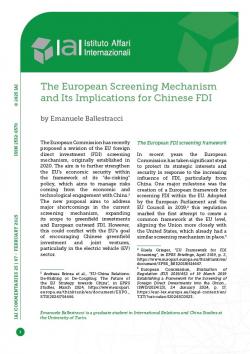The European Screening Mechanism and Its Implications for Chinese FDI
The European Commission has recently proposed a revision of the EU foreign direct investment (FDI) screening mechanism, originally established in 2020. The aim is to further strengthen the EU’s economic security within the framework of its “de-risking” policy, which aims to manage risks coming from the economic and technological engagement with China.[1] The new proposal aims to address major shortcomings in the current screening mechanism, expanding its scope to greenfield investments and European outward FDI. However, this could conflict with the EU’s goal of encouraging Chinese greenfield investment and joint ventures, particularly in the electric vehicle (EV) sector.
The European FDI screening framework
In recent years the European Commission has taken significant steps to protect its strategic interests and security in response to the increasing influence of FDI, particularly from China. One major milestone was the creation of a European framework for screening FDI within the EU. Adopted by the European Parliament and the EU Council in 2019,[2] this regulation marked the first attempt to create a common framework at the EU level, aligning the Union more closely with the United States, which already had a similar screening mechanism in place.[3]
The establishment of such a framework is part of a broader set of initiatives, including the Anti-Coercion Instrument, the EU Chips Act and the Critical Raw Materials Act.[4] These policies and instruments, introduced since 2018, laid the foundation of the more comprehensive EU “de-risking” strategy, launched under the von der Leyen Commission in 2023.[5] The latter signalled a shift from the EU’s traditional commitment to open markets to a more security-oriented economic stance, reflecting the downturn in the relations with China and Russia.
The current investment screening framework prioritises monitoring mergers and acquisitions (M&A) and establishes a cooperative mechanism between EU member states and the Commission rather than creating a centralised EU-wide screening body.[6] Although the responsibility for screening remains within individual member states, whose national regulations vary widely, the framework has brought considerable benefits: it encourages countries without existing screening measures to develop them, provides a more cohesive approach and allows the Commission to support national evaluations of critical investments.[7]
The evolution of Chinese FDI in Europe
Chinese investments in Europe were a major factor in prompting the Commission’s proposal to introduce – and then revise – the FDI screening framework. Chinese FDI in Europe grew significantly in the early 2010s, peaking in 2016 with 47.5 billion euros in investments.[8] Even though Chinese FDI only accounted for a small percentage of all foreign investment into the EU, their surge, particularly from state-owned enterprises (SOEs), attracted scrutiny and policy responses from the European Commission and Parliament. Concerns focused on issues like national security, state influence within Chinese firms and the presence of party cells in these companies – factors that the EU views as potential tools of Chinese economic statecraft.[9]
The increase in Chinese outward FDI in Europe can largely be attributed to policy changes in China, particularly liberalisation in the 2010s.[10] This provided private Chinese enterprises more freedom to engage in outward FDI, reducing the SOEs’ share in total Chinese FDI in Europe from 68 per cent in 2017 to 12 per cent by 2021.[11] While in principle this trend might have aligned with Europe’s liberal economic order, it faced heightened scrutiny, echoing past protectionist reactions to foreign investment, such as the US response to Japanese FDI in the 1980s or French responses to American FDI in the 1960s.[12]
Since its first draft proposal in 2017, the EU’s regulatory response has significantly impacted Chinese FDI, contributing to a steady decline of the latter from 2016 through 2023, from 47.5 to 6.8 billion euros.[13] Chinese investors have also shifted focus, moving from M&A to greenfield investments, which increased from 2 per cent of total Chinese FDI in 2017 to 78 per cent in 2023. Also in 2023, 70 per cent of the total Chinese FDI was EV-related, up from 61 per cent in 2022, with Hungary being the top destination, followed by France and Germany.[14] This shift indicates a preference for projects less sensitive to political and regulatory intervention, potentially reflecting both adaptation to European regulations and evolving strategic interests on China’s part.
The implications of greenfield investment screening for Europe’s EV sector
In January 2024, the European Commission proposed updates to the EU’s investment screening regulations, focusing on expanding targeted areas of intervention and addressing critical gaps in the current framework.[15] The new proposal aims to promote greater harmonisation, improve cooperation and enhance information sharing among member states. However, the most controversial aspect is the intention to broaden the regulations’ scope to include greenfield investments. This change is particularly relevant in the context of Chinese FDI and could conflict with the EU’s need to catch up in the EV sector, in which the investments of Chinese firms provide capital, know-how and jobs.[16]
Competitiveness in electromobility is essential for the EU to address the ongoing crisis in the European automotive sector, which accounts for 7 per cent of the bloc’s GDP,[17] and to achieve its ambitious climate goals. Bridging the competitive gap in this critical industry requires collaboration with Chinese firms, who are global leaders in the EV sector. To this end, the EU has adopted two interrelated strategies: imposing tariffs on made-in-China EVs and attracting Chinese greenfield investments in EV-related industries.[18] Tariffs, effective from 31 October 2024, aim to correct market distortions caused by Chinese subsidies that risk flooding the European market with under-priced EVs. While these measures shield EU companies from direct competition and allow them to scale up local capacities, they also encourage Chinese firms to invest in Europe to circumvent tariffs.[19]
Chinese greenfield investments are already reshaping the EV landscape in Europe: major Chinese firms have either started or planned to produce in the EU, such as BYD and CATL in Hungary and Geely in Belgium,[20] or have entered joint ventures with European counterparts, such as China’s Leapmotor with Stellantis and Chery with Spain’s EBRO-EV.[21]
The EU needs to see these investments not only as economic contributions but also as opportunities for technology transfer,[22] which is crucial for closing the competitive gap. For instance, in the battery sector, the EU has already proposed that Chinese firms share intellectual property with European counterparts in return for EU subsidies.[23] Moreover, integrating local content requirements (LCRs)[24] into bilateral FDI agreements would be another effective policy measure to ensure that greenfield investments deliver meaningful economic contributions and do not merely function as a workaround for tariffs through low-impact assembly plants. By mandating businesses to utilise a specific percentage of inputs from local intermediate products, many benefits can be achieved: increasing employment in the short term; developing the intermediate industry; fostering technology transfer due to spillovers and learning-by-doing in domestic supply.[25]
Thus, the emphasis of EU industrial policies should shift toward maximising the local value generated by such investments rather than their security implications. Both LCRs and the extension of the European investment screening framework to greenfield projects are essentially economic protectionist measures, hardly legitimised by security reasons. Indeed, security concerns associated with greenfield projects are usually modest, particularly as Chinese SOEs are no longer the primary actors in outbound FDI directed to the EU. Hence, while the expansion of the European investment screening framework may deter Chinese companies from undertaking investments in Europe,[26] as has already happened with Chinese M&A, implementing local content requirements can be an effective policy to foster EU competitiveness in the EV sector.
Emanuele Ballestracci is a graduate student in International Relations and China Studies at the University of Turin.
[1] Andreea Brinza et al., “EU-China Relations: De-Risking or De-Coupling. The Future of the EU Strategy towards China”, in EPRS Studies, March 2024, https://www.europarl.europa.eu/thinktank/en/document/EXPO_STU(2024)754446.
[2] Gisela Grieger, “EU Framework for FDI Screening”, in EPRS Briefings, April 2019, p. 2, https://www.europarl.europa.eu/thinktank/en/document/EPRS_BRI(2018)614667.
[3] European Commission, Evaluation of Regulation (EU) 2019/452 of 19 March 2019 Establishing a Framework for the Screening of Foreign Direct Investments into the Union… (SWD/2024/23), 24 January 2024, p. 17, https://eur-lex.europa.eu/legal-content/en/TXT/?uri=celex:52024SC0023.
[4] European Parliament and Council of the EU, Regulation (EU) 2019/452 of 19 March 2019 Establishing a Framework for the Screening of Foreign Direct Investments into the Union, http://data.europa.eu/eli/reg/2019/452/oj.
[5] European Commission, An EU Approach to Enhance Economic Security, 20 June 2023, https://ec.europa.eu/commission/presscorner/detail/en/ip_23_3358.
[6] Andreea Brinza et al., “EU-China Relations: De-Risking or De-Coupling”, cit.
[7] Gisela Grieger, “EU Framework for FDI Screening”, cit., p. 2-4.
[8] Agatha Kratz et al., “Dwindling Investments Become More Concentrated. Chinese FDI in Europe: 2023 Update”, in MERICS Reports, June 2023, p. 4, https://merics.org/en/node/2233.
[9] Gisela Grieger, “EU Framework for FDI Screening”, cit., p. 2.
[10] Shaun Breslin, “Chinese Economic Statecraft. An Illiberal Actor in a (More) Liberal Global Economy: Who Is Changing Who?”, in Giuseppe Gabusi (ed.), Drivers of Global Change. Responding to East Asian Economic and Institutional Innovation, Turin, Turin World Affairs Institute, 2021, p. 5-9, https://www.twai.it/?p=6888.
[11] Agatha Kratz et al., “Chinese FDI in Europe: 2021 Update”, in MERICS Reports, April 2022, p. 8-9, https://merics.org/en/node/1535.
[12] Zenobia T. Chan and Sophie Meunier, “Behind the Screen: Understanding National Support for a Foreign Investment Screening Mechanism in the European Union”, in The Review of International Organizations, Vol. 17, (2022), p. 513-541 at p. 521, https://doi.org/10.1007/s11558-021-09436-y.
[13] Agatha Kratz et al., “Dwindling Investments Become More Concentrated”, cit., p. 4.
[14] Ibid., p. 8-10.
[15] European Commission, Proposal for a Regulation on the Screening of Foreign Investments in the Union… (COM/2024/23), 24 January 2024, https://eur-lex.europa.eu/legal-content/en/TXT/?uri=celex:52024PC0023.
[16] Jörg Wuttke et al., “MERICS Forum: Chinese Investments in Europe”, in MERICS Comments, 17 October 2024, https://merics.org/en/node/2358.
[17] Kjeld van Wieringen, “The Future of European Electric Vehicles”, in EPRS In-Depth Studies, November 2024, p. 7, https://www.europarl.europa.eu/thinktank/en/document/EPRS_IDA(2024)762873.
[18] Giulio Piovaccari, “European Nations Compete for Chinese EV Factories, Jobs Even as EU Weighs Tariffs”, in Reuters, 10 June 2024, https://www.reuters.com/business/autos-transportation/european-nations-compete-chinese-ev-factories-jobs-even-eu-weighs-tariffs-2024-06-10.
[19] Victor De Decker, “Beyond Tariffs & Subsidies - How China’s EV Dominance Is Shaping EU Trade Strategy”, in Reconnect China Policy Briefs, No. 17 (November 2024), https://www.reconnect-china.ugent.be/?p=1265.
[20] Associated Press, “Chinese Tesla Rival BYD to Open Its First European EV Manufacturing Plant in Hungary”, in Euronews, 22 December 2023, https://www.euronews.com/next/2023/12/22/chinese-tesla-rival-byd-to-open-ev-manufacturing-plant-in-hungary; Oliver Gill, “Volvo to Shift EV Production to Europe to Escape China Tariffs”, in The Sunday Times, 8 June 2024, https://www.thetimes.com/business-money/companies/article/volvo-to-shift-ev-production-to-europe-to-escape-china-tariffs-btx9swhr6.
[21] Stellantis, Stellantis to Become a Strategic Shareholder of Leapmotor with €1.5 Billion Investment and Bolster Leapmotor’s Global Electric Vehicle Business, 26 October 2023, https://www.stellantis.com/en/news/press-releases/2023/october/stellantis-to-become-a-strategic-shareholder-of-leapmotor-with-1-5-billion-investment-and-bolster-leapmotor-s-global-electric-vehicle-business; “China’s Chery to Open Its First European Manufacturing Site in Spain”, in Reuters, 16 April 2024, https://www.reuters.com/business/autos-transportation/chinas-chery-will-open-spain-its-first-european-manufacturing-site-2024-04-16.
[22] Francesca Ghiretti, “EU Tariffs Must Be Part of a Multipronged Strategy”, in CSIS Commentaries, 31 October 2024, https://www.csis.org/node/113087.
[23] Alice Hancock, Andy Bounds and Alec Russell, “EU to Demand Technology Transfers from Chinese Companies”, in Financial Times, 19 November 2024, https://www.ft.com/content/f4fd3ccb-ebc4-4aae-9832-25497df559c8.
[24] Francesca Ghiretti, “EU Tariffs Must Be Part of a Multipronged Strategy”, cit.
[25] Chih-Ming Hung and Yungho Weng, “Optimal Local Content Requirement under Export Share Requirement Consideration”, in International Review of Economics & Finance, Vol. 92 (April 2024), p. 114-122 at p. 114-115, DOI 10.1016/j.iref.2024.02.027.
[26] James Kynge, “Chinese Investment in Europe Falls as Watchdogs Increase Scrutiny”, in Financial Times, 9 May 2023, https://www.ft.com/content/2abfba16-e76e-4667-980f-73aeb993b997.
-
Dati bibliografici
Roma, IAI, febbraio 2025, 5 p. -
In:
-
Numero
25|07




